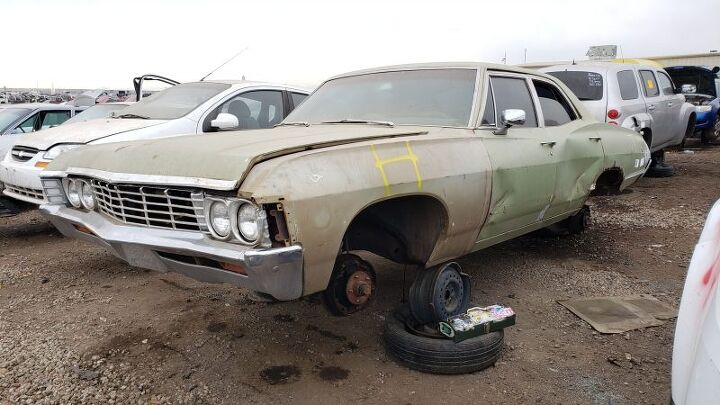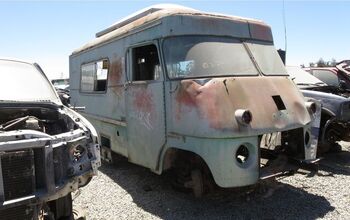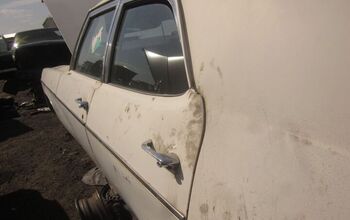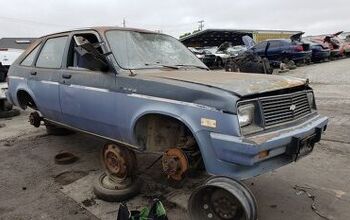Junkyard Find: 1967 Chevrolet Impala Sedan

During the middle 1960s, the Chevrolet full-sized sedan was the most mainstream car in North America. The pinnacle for sales numbers came in 1965, with way more than a million new big Chevrolets sold, but 1967 saw 1,127,700 Biscaynes, Bel Airs, Impalas, and Caprices leave the showrooms (if you include wagons in the count, and of course you should).
Of all these full-sized Chevy cars in 1967, by far the most common was the Impala four-door post sedan, and that’s we’ve got for today’s Junkyard Find.
The point I’m trying to make with those production figures is that the 1967 Impala sedan is one of the top-10 most-produced cars in American history, maybe even top five, and so we should all avoid getting angry about the blasphemous modifications its (presumable) final owner performed to keep it on the road during its final years.
GM didn’t spend extra pennies on making Impala seats last for the long haul during the 1960s; if you wanted upholstery longevity, you got a Cadillac (or at least a Buick). Someone grabbed what appears to be the split bench seat out of a 1980s or 1990s GM luxury car (I’m guessing Buick or Oldsmobile) and swapped it into this Impala.
On the driver’s side, the factory power seat-adjustment controls stayed in their original location.
Things get interesting on the passenger side, though, with the controls moved to the door panel. Running the wiring from the door to the body must have been a real headache, so this seat swap went above and beyond the usual quick-and-dirty treatment.
Then, because 1967-style lap belts don’t keep you from getting a faceful of steel dashboard in a not-very-high-speed crash, modern-ish shoulder belts have been retrofitted into this car. I did much the same thing with my ’65 Impala sedan, though I used Ford Escort bucket seats (because they were free) and non-retracting shoulder belts from a late-1960s Impala (because they were the correct size and I just had to drill mounting holes in the B-pillars in the same location GM used in 1969).
The Rust Monster took a few bites out of this car along the way, maybe as bad as you’d have seen on a ’67 Impala by about, oh, 1973 in Illinois.
Somebody grabbed the engine, but we can tell by the shadows left behind by the now-pried-off fender badges that this ’67 started its career with the not-so-exciting 195-horsepower 283-cubic-inch small-block V8, coupled with the two-speed Powerglide automatic rather than the base 3-on-the-tree manual (of course, there’s no telling what engines might have been swapped in by the time this car finished its career). A 155-horse 250-cubic-inch straight-six came as standard equipment in the 1967 Impala, but that was the sort of thing only downscale Biscayne buyers and fleet purchasers settled for. You could get all the way up to 385 horsepower from a not-so-civilized 427 in 1967, as well as a 4-on-the-floor manual or three-speed Turbo Hydra-Matic slushbox.
You can see that this Impala’s final owner added 4.2 gallons of gas just 14.5 miles from the end of its long road.
The late-1980s/early-1990s cassette deck (with auto-stop) must have made road trips nicer than the staticky factory AM radio would have made them.
A very cool machine, but not rare and definitely not valuable. A 1967 factory big-block car, a two-door hardtop, or a convertible would have been worth saving in this condition, of course. I still see full-sized Chevrolet sedans of this era at U-Wrench yards, even in recent years.
The coupe looked much nicer, of course, so nice that you really needed a glass garage to show it off.
It looked good even when sliced in half.
If you want to find links to better than 2,000 more Junkyard Finds, head over to the Junkyard Home of the Murilee Martin Lifestyle Brand™.

Murilee Martin is the pen name of Phil Greden, a writer who has lived in Minnesota, California, Georgia and (now) Colorado. He has toiled at copywriting, technical writing, junkmail writing, fiction writing and now automotive writing. He has owned many terrible vehicles and some good ones. He spends a great deal of time in self-service junkyards. These days, he writes for publications including Autoweek, Autoblog, Hagerty, The Truth About Cars and Capital One.
More by Murilee Martin
Latest Car Reviews
Read moreLatest Product Reviews
Read moreRecent Comments
- Carson D Just don't be the whistleblower who reports on the falsification of safety data. That's a deadly profession.
- Carson D I'd have responded sooner, but my computer locked up and I had to reboot it.
- Todd In Canada Mazda has a 3 year bumper to bumper & 5 year unlimited mileage drivetrain warranty. Mazdas are a DIY dream of high school auto mechanics 101 easy to work on reliable simplicity. IMO the Mazda is way better looking.
- Tane94 Blue Mini, love Minis because it's total custom ordering and the S has the BMW turbo engine.
- AZFelix What could possibly go wrong with putting your life in the robotic hands of precision crafted and expertly programmed machinery?






















































Comments
Join the conversation
Wasn't this the same Impala that the scary thin dude used to run over a poor victim in "Blue Thunder"? Could be a movie car. I remember as a pre-teen , the older brother of a friend of mine drove a ratty Impala SS coupe. So loud. It amused me because it was such a large car to me (this was the mid 80s). Adding to this is that he stood about 5'1''
My Grandpop had a gold 1967 Chevrolet Bel Air sedan with a black cloth and vinyl interior. I loved the dashboard on these cars. The instrument panel appeared to go all the way to the floor to a little kid sitting in the passenger seat.